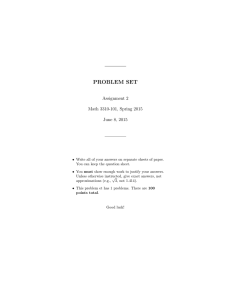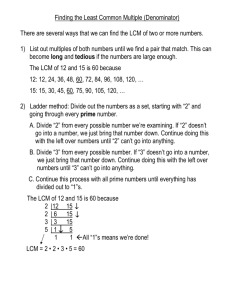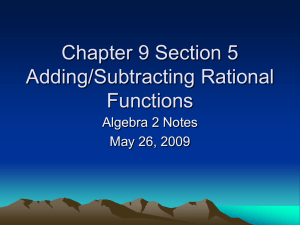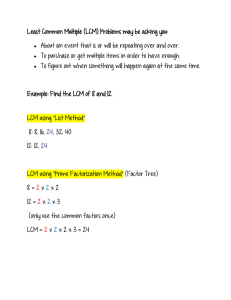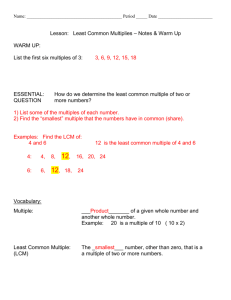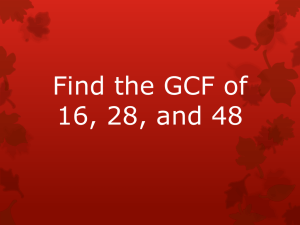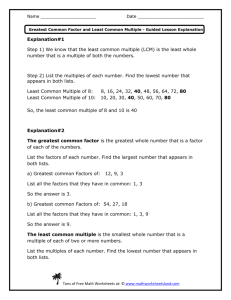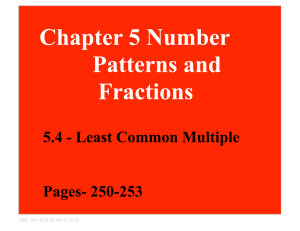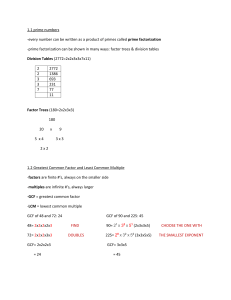Introduction to Review Materials
advertisement
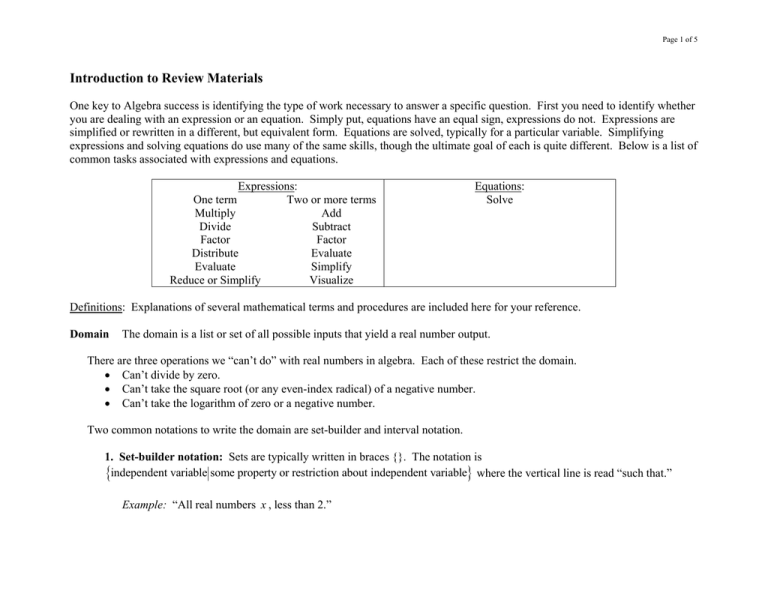
Page 1 of 5
Introduction to Review Materials
One key to Algebra success is identifying the type of work necessary to answer a specific question. First you need to identify whether
you are dealing with an expression or an equation. Simply put, equations have an equal sign, expressions do not. Expressions are
simplified or rewritten in a different, but equivalent form. Equations are solved, typically for a particular variable. Simplifying
expressions and solving equations do use many of the same skills, though the ultimate goal of each is quite different. Below is a list of
common tasks associated with expressions and equations.
Expressions:
One term
Two or more terms
Multiply
Add
Divide
Subtract
Factor
Factor
Distribute
Evaluate
Evaluate
Simplify
Reduce or Simplify
Visualize
Equations:
Solve
Definitions: Explanations of several mathematical terms and procedures are included here for your reference.
Domain
The domain is a list or set of all possible inputs that yield a real number output.
There are three operations we “can’t do” with real numbers in algebra. Each of these restrict the domain.
• Can’t divide by zero.
• Can’t take the square root (or any even-index radical) of a negative number.
• Can’t take the logarithm of zero or a negative number.
Two common notations to write the domain are set-builder and interval notation.
1. Set-builder notation: Sets are typically written in braces {}. The notation is
{independent variable some property or restriction about independent variable} where the vertical line is read “such that.”
Example: “All real numbers x , less than 2.”
Page 2 of 5
{ x x < 2}
Example: “All real numbers x , not equal to 9.”
{ x x ≠ 9}
Example: “All real numbers n , greater than or equal to −4 and less than 6.”
{n − 4 ≤ n < 6}
2. Interval notation: A parenthesis indicates the starting or ending value is not included and a square bracket indicates the
starting or ending value is included. Within the parentheses or square bracket, we indicate the smallest value of x followed by
a comma and then the largest value of x .
Example: “All numbers x , less than 2.”
( −∞, 2 )
Example: “All numbers x , not equal to 9.”
The mathematical symbol U means “union” or “or”.
( −∞,9 ) U ( 9, ∞ )
Example: “All numbers n , greater than or equal to −4 and less than 6.”
[ −4, 6 )
Equivalent FractionsFractions that are equal when simplified.
Example:
Expression
2 3 5
40
1
are equivalent fractions because they all reduce to .
, ,
, and
3
6 9 15
120
A collection of numbers, variables, grouping symbols and operations. An expression is made up of one or more terms.
Factor (noun) Expressions that are multiplied together.
A factor is any object (integer or polynomial) that exactly divides another object.
Page 3 of 5
Factor (verb) To factor an integer means write the integer as a product of prime numbers.
To factor a polynomial means to write the polynomial as the product of two or more polynomials of lower degree.
Greatest Common Factor (GCF) The greatest common factor of two or more objects (integers or polynomials) is the largest
quantity that divides (without remainder) all of the objects.
Example: Find the GCF of 42 and 60.
Start by factoring each expression completely. That is, write each number as a product of prime numbers.
42 = 6 ∗ 7
= ( 2 ∗ 3) ∗ 7
60 = 6 ∗10
= ( 2 ∗ 3) ∗ ( 2 ∗ 5 )
= 2 ∗ 2 ∗3∗5
To “build” the GCF, identify the factors that are common to each integer. Notice 42 and 60 each have a factor of 2 and
3, therefore the GCF is 2 ∗ 3 or 6. That is the largest number that divides evenly into both 42 and 60 is 6.
Example: Find the GCF of 9 x 2 y 2 and 30 x3 y .
Factor each expression completely.
9x2 y 2 = 3 ∗ 3 ∗ x ∗ x ∗ y ∗ y
30 x3 y = 2 ∗ 3 ∗ 5 ∗ x ∗ x ∗ x ∗ y
Each expression has one 3, two x ’s, and one y . Therefore the GCF is 3x 2 y . Recall this means the largest expression
that divides evenly into 9 x 2 y 2 and 30 x 3 y is 3x 2 y .
Least Common Denominator (LCD)
denominators.
The least common denominator is the least common multiple of all involved
Page 4 of 5
Least Common Multiple (LCM) The least common multiple of two or more objects (integers or polynomials) is the smallest
quantity that all the objects divide into evenly.
Example: Find the LCM of 42 and 60.
Factor each expression completely.
42 = 6 ∗ 7
= ( 2 ∗ 3) ∗ 7
60 = 6 ∗10
= ( 2 ∗ 3) ∗ ( 2 ∗ 5 )
= 2 ∗ 2 ∗3∗5
The LCM is the product of the most number of times each factor occurs in any one of the objects. The factor 2 appears
once in 42 and twice in 60, therefore the LCM includes two 2’s. The factor of 3 appears once in 42 and once in 60,
therefore the LCM includes one 3. The factor of 5 does not appear in 42 and once in 60, therefore the LCM includes
one 5. Finally the factor of 7 appears once in 42 and does not appear in 60, so it appears once in the LCM. Therefore
the LCM is 2 ∗ 2 ∗ 3 ∗ 5 ∗ 7 or 420. Thus 420 is the smallest integer that is exactly divisible by both 42 and 60.
Example: Find the LCM of 9 x 2 y 2 and 30 x 3 y .
Start by factoring each expression.
9x2 y2 = 3 ∗ 3 ∗ x ∗ x ∗ y ∗ y
30 x 3 y = 2 ∗ 3 ∗ 5 ∗ x ∗ x ∗ x ∗ y
The LCM is the product of the most number of times each factor occurs in any of the objects. The factor 2 does not
appear in 9 x 2 y 2 and appears once in 30 x 3 y . The LCM includes one 2. The factor of 3 appears twice in 9 x 2 y 2 and
once in 30 x 3 y , so the LCM includes two 3’s. The factor 5 does not appear in 9 x 2 y 2 and appears once in 30 x 3 y , so the
LCM includes one 5. The factor x appears twice in 9 x 2 y 2 and three times in 30 x 3 y , so the LCM includes three x ’s.
Finally, the factor y appears twice in 9 x 2 y 2 and once in 30 x 3 y , so the LCM includes two y ’s. Thus the LCM is
2 ∗ 3 ∗ 3 ∗ 5 ∗ x ∗ x ∗ x ∗ y ∗ y or 90x 3 y 2 . (Recall this means the smallest expression that both 9x 2 y 2 and 30x 3 y divide
evenly into is 90x3 y 2 .)
Page 5 of 5
Perfect Square
An expression is a perfect square if it can be written as some expression squared.
Example: 9 is a perfect square because it can be written as 32 .
Example: 64x 2 is a perfect square because it can be written as ( 8x ) .
2
Polynomial
A polynomial is an algebraic expression of the form an x n + an−1 x n−1 + ... + a1 x1 + a0 , where an , an−1 ,..., a1 , a0 are all real
numbers and the exponents n, n − 1,... are all whole numbers.
Monomial
A one-term polynomial.
7 , − 3x 2 , 9 p 3 q are examples of monomials.
Binomial
A two-term polynomial.
x + 1 , 9t 2 − 5t , x 3 + 2 x are examples of binomials.
Trinomial
A three-term polynomial.
2
x + 7 x + 12 , 9r 4 − 5r 3 + 2r , x 2 y − 2 xy 2 + 5 xy are examples of trinomials.
Term
May be composed of a number called the coefficient, variable(s), and perhaps exponents. Only multiplication and division
occur within a term. Addition and subtraction separate terms.
9
x+3
4 x 2 y − 19 xy 5 + 7
3 p (4 p − 7)
12 p − 21 p
2
1 term
2 terms
3 terms
1 term
2 terms
